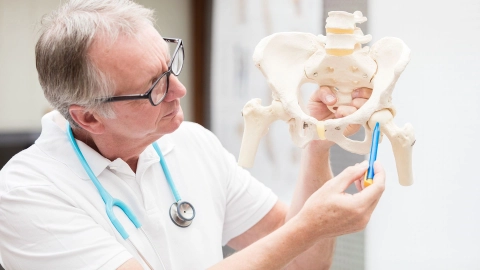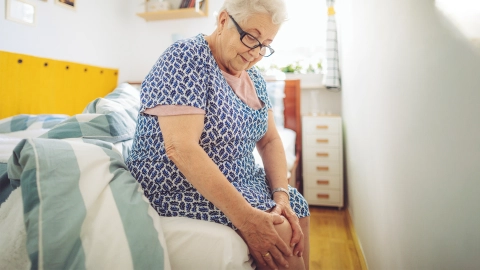Conditions Osteoarthritis
Osteoarthritis (also known as arthrosis) occurs due to wear and tear on the joints, and is often associated with the aging process. Joint stiffness and joint pain are typical symptoms. This article provides an overview of the symptoms, progression, and treatment of osteoarthritis.
At a glance
- In early-stage osteoarthritis, the joints are usually only painful when bearing weight.
- As the disease worsens over time, the pain increases and begins to restrict daily life.
- Anyone can get osteoarthritis.
- Many people suffer from this condition as part of the aging process.
- The typical symptoms are joint stiffness and pain.
- It is important to maintain and active lifestyle with lots of movement despite osteoarthritis.
Note: The information in this article cannot and should not replace a medical consultation and must not be used for self-diagnosis or treatment.

What is osteoarthritis?
Osteoarthritis is a disease in which the cartilage between two bones becomes thinner and rougher. Over time, the joints become stiff and begin to be painful, which restricts mobility.
A certain amount of joint wear is normal, and so this is a disease that mainly affects older people. However, osteoarthritis may also occur during middle age. The most common forms are:
- knee osteoarthritis (gonarthrosis)
- hip osteoarthritis (coxarthrosis)
- finger osteoarthritis
- vertebral joint osteoarthritis (facet syndrome)
What are the signs of osteoarthritis?
The first sign of osteoarthritis is pain when pressure is placed on the joints. Impact stress, for example, during jogging, often triggers stabbing pains in the knees and hips. If pain also occurs when at rest, this indicates that the osteoarthritis is already at a very advanced stage.
In the advanced stages, the joints are also stiff after longer periods of rest. In the morning, after a long time spent lying down, it is common to experience “start-up pain”, which quickly improves with movement. If mobility fails to improve after 30 minutes, the cause is more likely to be a rheumatic joint inflammation, i.e., rheumatoid arthritis.
What causes osteoarthritis?
The video below explains how osteoarthritis develops and what causes it.
This and other videos can also be found on YouTube
Watch nowThe privacy policy indicated there applies.
What are the causes of osteoarthritis?
Where two bones meet at a joint, cartilage acts as a necessary buffer between them. Cartilage is exposed to extreme pressure but is repaired to a certain extent by specialized cells. These obtain the nutrients they require to do so from synovial fluid (joint fluid) the rather than from the blood. With fluctuating pressure during movement, metabolic by-products are squeezed out of the cartilage as through a sponge and fresh nutrients are soaked up.
Despite this, the cartilage layer becomes thinner and rougher over time. Joint wear is a normal part of the aging process. However, only 25 percent of people with visible osteoarthritis on an x-ray suffer health complaints as a result. Osteoarthritis can progress to the point where the cartilage is so worn down that the bone is no longer protected.
What are the risk factors for osteoarthritis?
As osteoarthritis is due to degeneration of the joints, the most significant risk factor is age. Around 10 percent of 30- to 40-year-olds report having osteoarthritis. Among 60- to 70-year-olds, this figure rises to 40 percent.
Certain factors may accelerate joint wear:
- family history
- playing certain types of sport, such as football or handball, which places stress on the joints
- frequent kneeling, crouching, or heavy lifting at work
- cruciate ligament rupture, meniscus damage, or other knee injuries
- disorders of the joints, e.g., the hips
- obesity
How does osteoarthritis progress?
Many people with osteoarthritis lead normal lives and are able to tolerate varying levels of pain over a period of years. However, the progression of the disease may differ greatly among individuals, and symptoms may quickly become more severe. Continuous pain and limited mobility are common if the bone margins change and form small bony projections known as bone spurs (osteophytes). In the advanced stage of osteoarthritis, the bones may be heard and felt rubbing together, producing joint sounds and continuous pain.
How is osteoarthritis diagnosed?
In most cases, doctors can diagnose osteoarthritis from the typical symptoms. One typical change that can be detected is a narrow joint gap that is clearly discernible on an x-ray. In this case, further tests are not required in order to make a diagnosis.
If few of the typical symptoms are present, blood tests or an MRI may be necessary to exclude other diseases, such as rheumatoid arthritis.
How is osteoarthritis treated?
The most important therapeutic measure for osteoarthritis is to remain active. Inactivity leads to reduced muscle strength, and may accelerate cartilage degeneration. While a cure for osteoarthritis has not yet been found, an active lifestyle will keep the body mobile and flexible. This is particularly true if the knee or hip are affected. In addition, a wide range of treatments are available for alleviating the pain associated with osteoarthritis. These differ depending on which joint is affected.
Only a small number of treatments have been substantiated by scientific studies showing that they actually slow down or reduce the effects of the disease. The most effective methods include movement therapies, physical rehabilitation, and the use of painkillers.
Obese individuals with osteoarthritis in their knee or hip are also encouraged to lose weight. In the case of osteoarthritis in the finger or wrist, occupational therapy can help individuals to avoid movements that cause excessive joint strain. Aids that provide relief for painful joints are also available, such as special pens or tools for gripping and opening glasses and bottles. Walking sticks or stabilizing splints may also help with osteoarthritis in the knee and hip.
Once the disease has progressed to a certain point, it may be useful to replace the worn joint surface partially or fully with an artificial joint, known as an endoprosthesis.
Important: The effectiveness of many of the treatments offered for osteoarthritis has not yet been proven. These include acupuncture, arthroscopy, herbal medicines, dietary supplements, ultrasound therapies, and transcutaneous electrical nerve stimulation (TENS).
For more detailed information, e.g., on painkillers for osteoarthritis, see gesundheitsinformation.de.
- Aresti N, Kassam J, Nicholas N, Achan P. Hip osteoarthritis. BMJ 2016; 354: i3405. Aufgerufen am 29.04.2020.
- Bennell KL, Hunter DJ, Hinman RS. Management of osteoarthritis of the knee. BMJ 2012; 345: e4934. Aufgerufen am 29.04.2020.
- Deutsche Gesellschaft für Orthopädie und Orthopädische Chirurgie (DGOOC). Gonarthrose. S2k-Leitlinie. AWMF-Registernummer 033-004. 01.2018. Aufgerufen am 29.04.2020.
- National Institute for Health and Care Excellence (NICE). Osteoarthritis: care and management in adults. NICE Clinical Guidelines; Band 177. 02.2014. Aufgerufen am 29.04.2020.
- Robert Koch-Institut (RKI), Statistisches Bundesamt (Destatis). Arthrose. 2013. (Gesundheitsberichterstattung des Bundes; Band 54). Aufgerufen am 29.04.2020.
In cooperation with the Institute for Quality and Efficiency in Health Care (Institut für Qualität und Wirtschaftlichkeit im Gesundheitswesen) (IQWiG).
As at:





